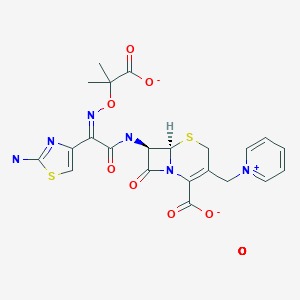Attribution Statement: LactMed is a registered trademark of the U.S. Department of Health and Human Services.
NCBI Bookshelf. A service of the National Library of Medicine, National Institutes of Health.
Drugs and Lactation Database (LactMed®) [Internet]. Bethesda (MD): National Institute of Child Health and Human Development; 2006-.
CASRN: 78439-06-2

Drug Levels and Effects
Summary of Use during Lactation
Limited information indicates that ceftazidime produces low levels in milk that are not expected to cause adverse effects in breastfed infants. Occasionally disruption of the infant's gastrointestinal flora, resulting in diarrhea or thrush have been reported with cephalosporins, but these effects have not been adequately evaluated. Ceftazidime and is acceptable in nursing mothers.
Drug Levels
Maternal Levels. Ceftazidime 2 grams was given to 11 women intravenously every 8 hours for 5 days. The average trough milk level was 3.8 mg/L before the next dose, 5.2 mg/L 1 hour after the dose and 4.5 mg/L at 3 hours after the dose. These differences were not statistically significant. The average drug concentrations in milk were 3.9 mg/L for samples before the seventh dose and 4.9 mg/L in milk samples after the seventh dose, but this difference was not statistically significant. There was no correlation between the mother's weight and the ceftazidime milk levels.[1]
Infant Levels. Relevant published information was not found as of the revision date.
Effects in Breastfed Infants
Relevant published information was not found as of the revision date.
Effects on Lactation and Breastmilk
Relevant published information was not found as of the revision date.
References
- 1.
- Blanco JD, Jorgensen JH, Castaneda YS et al. Ceftazidime levels in human breast milk. Antimicrob Agents Chemother. 1983;23:479-80. [PMC free article: PMC184672] [PubMed: 6342531]
Substance Identification
Substance Name
Ceftazidime
CAS Registry Number
78439-06-2
Drug Class
- Breast Feeding
- Lactation
- Anti-Infective Agents
- Antibacterial Agents
- Cephalosporins
Disclaimer: Information presented in this database is not meant as a substitute for professional judgment. You should consult your healthcare provider for breastfeeding advice related to your particular situation. The U.S. government does not warrant or assume any liability or responsibility for the accuracy or completeness of the information on this Site.
- User and Medical Advice Disclaimer
- Drugs and Lactation Database (LactMed) - Record Format
- LactMed - Database Creation and Peer Review Process
- Fact Sheet. Drugs and Lactation Database (LactMed)
- Drugs and Lactation Database (LactMed) - Glossary
- LactMed Selected References
- Drugs and Lactation Database (LactMed) - About Dietary Supplements
- Breastfeeding Links
- PMCPubMed Central citations
- PubChem SubstanceRelated PubChem Substances
- PubMedLinks to PubMed
- Review Ceftazidime and Avibactam.[Drugs and Lactation Database (...]Review Ceftazidime and Avibactam.. Drugs and Lactation Database (LactMed®). 2006
- Review Cefixime.[Drugs and Lactation Database (...]Review Cefixime.. Drugs and Lactation Database (LactMed®). 2006
- Review Cefepime.[Drugs and Lactation Database (...]Review Cefepime.. Drugs and Lactation Database (LactMed®). 2006
- Review Cefditoren.[Drugs and Lactation Database (...]Review Cefditoren.. Drugs and Lactation Database (LactMed®). 2006
- Review Cefdinir.[Drugs and Lactation Database (...]Review Cefdinir.. Drugs and Lactation Database (LactMed®). 2006
- Ceftazidime - Drugs and Lactation Database (LactMed®)Ceftazidime - Drugs and Lactation Database (LactMed®)
- Botulin A - Drugs and Lactation Database (LactMed®)Botulin A - Drugs and Lactation Database (LactMed®)
- SLC33A1 [Coturnix japonica]SLC33A1 [Coturnix japonica]Gene ID:107318408Gene
Your browsing activity is empty.
Activity recording is turned off.
See more...
